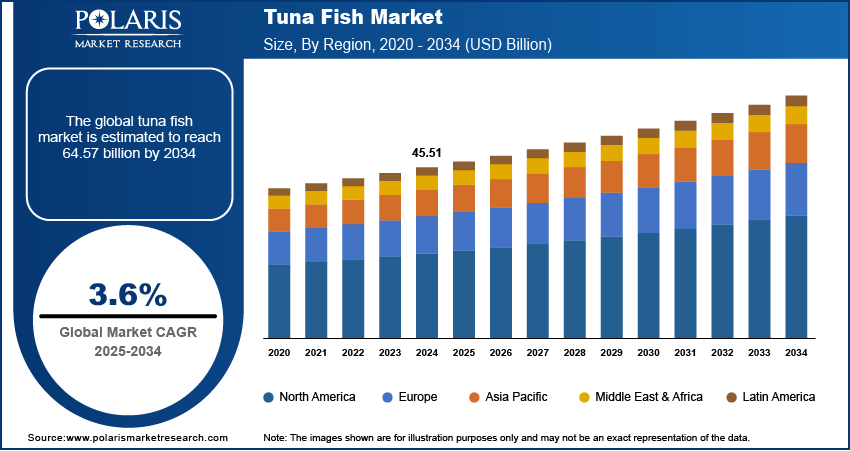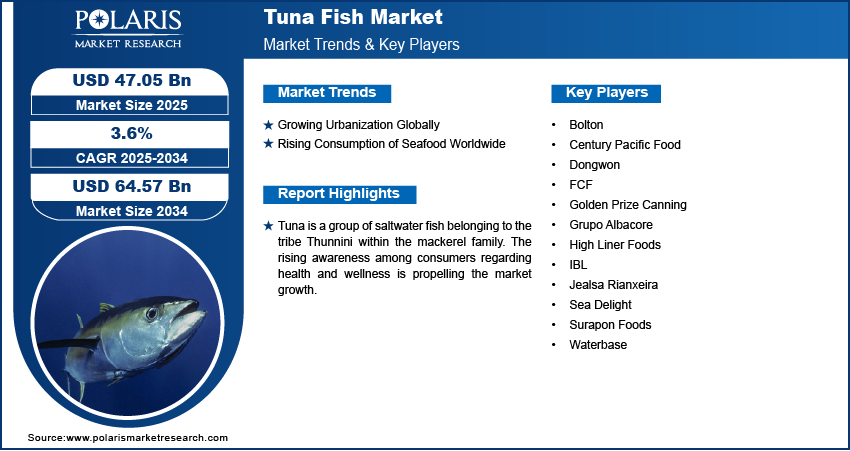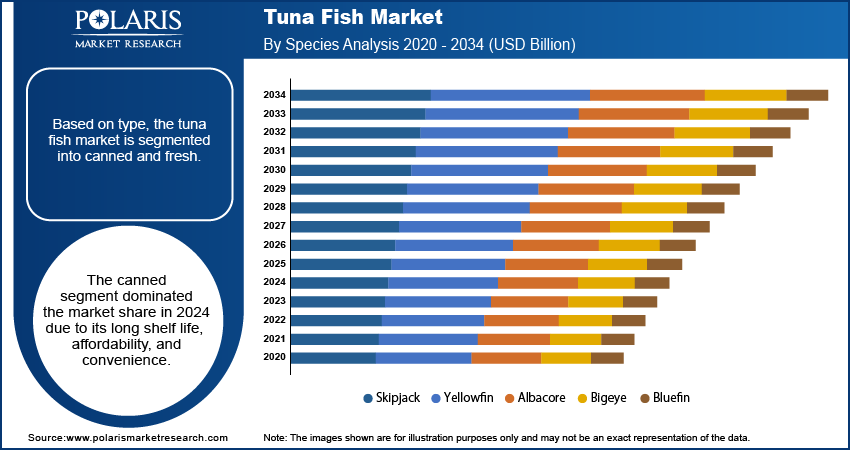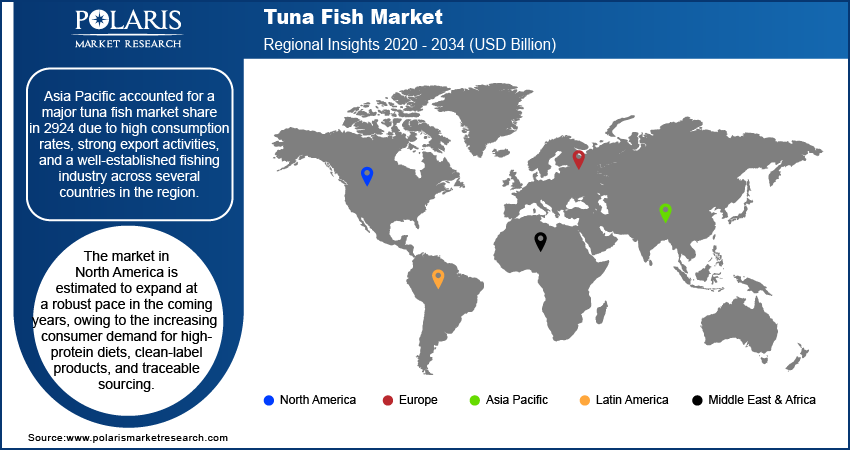
Tuna Fish Market Share, Size, Trends, Industry Analysis Report, By Species (Skipjack, Albacore, Yellowfin, Bigeye, Bluefin); By Type; By Region; Segment Forecast, 2024 - 2032
- Published Date:Jan-2024
- Pages: 115
- Format: PDF
- Report ID: PM3384
- Base Year: 2023
- Historical Data: 2019-2022
Report Outlook
The global Tuna Fish Market size was valued at USD 42.47 billion in 2024. The tuna fish industry is projected to USD 51.76 billion by 2032, exhibiting a CAGR of 2.5% during 2024- 2032.
Tuna is one of the most highly valued fish species globally, and its demand has been increasing over the years due to its high nutritional value and unique taste. However, overfishing of wild tuna populations has led to declining stocks, making it difficult for commercial fishermen to meet the growing demand.

To Understand More About this Research: Request a Free Sample Report
Global consumption of fish and other seafood climbed steadily through time, rising from 9.9 kilograms in the 1960s to 11.4 kilograms in the 1970s, 12.5 kilograms in the 1980s, 14.4 kilograms in the 2000s, and 19.6 kilograms in the 2010s, before reaching record high of 20.5 kilograms in 2019. About half of the world's production in 2020 will come from aquaculture. This has been done to meet the demand for fish without depleting fish stocks.
Tuna is a significant source of Omega-3 fatty acids crucial for preserving heart health, brain function, and general well-being. As consumers become more aware of the health benefits of omega-3s, the demand for tuna is increasing. The largest consumers of canned tuna are the European Union, the U.S. & Japan, who consume 51%, 31%, and 6% of the world's canned tuna products, respectively.
Over 1 billion pounds of canned and packed tuna are consumed annually in the United States. Regarding sales per square foot of shelf space in grocery stores, only coffee and sugar outperform canned tuna. According to research, 23 percent of American consumers serve tuna once each week. Another 40% of households offer canned tuna 2-3 times per month, 29% have it once per month, and 10% do so every three months or so. This will further fuel the demand for the tuna market in the coming years.

Industry Dynamics
Growth Drivers
The growing seafood consumption, including tuna, in coastal areas is a significant driver of the tuna fish market. Coastal regions have a long-standing tradition of seafood consumption due to their proximity to fishing grounds and access to a wide variety of fresh seafood.
Tuna is particularly popular among seafood consumers due to its rich nutritional value and delicious taste. Tuna is a good source of high-quality protein, an essential nutrient for building and repairing body tissues and supporting muscle growth. As consumers become increasingly health-conscious and seek protein-rich food options, tuna is an excellent choice.
Moreover, the rising popularity of sushi and sashimi has also contributed to the increased demand for tuna. Tuna is a favored ingredient in these traditional Japanese dishes, which have gained worldwide popularity. The demand for sushi-grade tuna, known for its freshness and premium quality, has grown significantly, driving the tuna fish market.
According to the World Economic Forum, coastal countries such as Iceland and the Maldives have the highest levels of seafood consumption, averaging more than 80 kg per person per year. These regions often have a strong cultural connection to seafood and rely on it as a staple food source. The rich nutritional value of tuna and its taste and versatility in dishes like sushi has fueled its demand. As consumers prioritize health-conscious choices and seek protein-rich foods, the demand for tuna will continue its upward trajectory in the coming years.
Report Segmentation
The market is primarily segmented based on species, type, and region.
|
By Species |
By Type |
By Region |
|
|
|
To Understand the Scope of this Report: Speak to Analyst
Skipjack is expected to witness higher growth over the projected period.
The skipjack segment is projected to witness higher growth in the coming years. This is one of the world's most harvested and consumed species of tuna fish. It is a small, fast-growing tuna species that can be found in tropical and subtropical waters around the world.
Skipjack tuna has become a driving force in the market’s growth as it is a highly sustainable tuna species. This means it can be harvested in large quantities without depleting its population. As a result, skipjack tuna has become a popular choice for commercial and artisanal fisheries and is widely available in supermarkets and restaurants.
Skipjack tuna is relatively affordable compared to other tuna species, making it an attractive option for cost-conscious consumers. This has helped drive the market's growth as more and more consumers seek affordable, sustainable, and versatile seafood options. According to the Marine Stewardship Council, Skipjack is the most popular variety of tuna sold worldwide since it makes up 60% of the world's tuna catch and is the most prevalent in the ocean.
Canned accounted for the largest market share in 2022
The canned segment witnessed a larger market share in 2022, and the growth trajectory is projected to continue throughout the study period owing to the convenient and affordable option for consumers. The long shelf life of canned tuna is one of its main benefits. Since canned tuna can be stored for a long time without going bad, it is a common option for people searching for a quick and simple source of protein.
Canned tuna is also widely available in supermarkets and other food retailers, making it an accessible option for consumers worldwide. According to NFI, consumption of canned tuna increased in 2020, Americans consumed 2.6 pounds of the shelf-stable species per person. Americans consumed 2.2 pounds of canned tuna per person in 2019. This will further fuel the growth of the market in the upcoming years.

Europe dominated the global market in 2022
Europe emerged as the dominant player in the global market. This market dominance can be attributed to several factors, including high per capita fish and seafood consumption and a well-organized seafood industry in the region. The European Market Observatory for Fisheries and Aquaculture Products (EUMOFA) claims that European consumers spend a whopping USD 67.3 billion annually, making them the world's largest seafood consumers.
In recent years, European consumers have displayed a strong inclination towards healthy and functional foods, particularly after the COVID-19 pandemic, as they prioritize maintaining a healthy and active lifestyle. Companies have focused on developing products with added health benefits in response to this increased demand. For instance, in September 2021, John West, a brand of the Thai Union Group, introduced a range of nutrient-rich canned tuna in European grocery stores. The product line includes flavors like Energy, Heart, and Immunity, catering to young consumers seeking taste and health benefits.
The Asia Pacific region is anticipated to hold the second-largest market share and has witnessed rapid growth. The region's growing population and rising per capita income have contributed to increased demand for seafood. Asia has seen significant growth in seafood and aquaculture production and processing, meeting the surging demand. Over the past two decades, Asia has dominated global aquaculture production, accounting for 89% of the share. The region boasts the largest fleet in the fisheries sector, with 3.1 million vessels in 2018.
Moreover, the aquaculture sector in Asia provides substantial employment opportunities, further fueling its growth. The development of the aquaculture industry is predicted to impact the tuna fish market positively. The increasing demand for seafood and Asia's dominance in aquaculture production position the region as a key player in the global tuna fish market.

Competitive Insight
Some of the major players operating in the global market include High Liner Foods, Surapon Foods, Thai Union, Waterbase, ITOCHU, Dongwon, IBL, Century Pacific Food, Bolton, Jealsa Rianxeira, Grupo Albacore, CANNING, Bumble Bee Foods, Golden Prize Canning, Crown Prince, FCF, American Tuna & Sea Delight.
Recent Developments
- In January 2023, Atlanta's Table introduced one readymade smoked tuna. The line's products include smoked tuna in soybean oil, smoked tuna in soybean oil with lemon & oregano, including others.
- In January 2023, Vgarden, a food technology start-up, added canned tuna without fish to its private-label meat and dairy replacements portfolio. According to the company, tuna manufactured from pea protein was developed to offer a vegan.
Tuna Fish Market Report Scope
|
Report Attributes |
Details |
|
Market size value in 2024 |
USD 42.47 billion |
|
Revenue forecast in 2032 |
USD 51.76 billion |
|
CAGR |
2.5% from 2024 - 2032 |
|
Base year |
2023 |
|
Historical data |
2019 - 2022 |
|
Forecast period |
2024 - 2032 |
|
Quantitative units |
Revenue in USD billion and CAGR from 2024 to 2032 |
|
Segments covered |
By Species, By Type, By Region |
|
Regional scope |
North America, Europe, Asia Pacific, Latin America; Middle East & Africa |
|
Key companies |
High Liner Foods, Surapon Foods, Thai Union, Waterbase, ITOCHU, Dongwon, IBL, Century Pacific Food, Bolton, Jealsa Rianxeira, Grupo Albacore, CANNING, Bumble Bee Foods, Golden Prize Canning, Crown Prince, FCF, American Tuna & Sea Delight. |
FAQ's
The global tuna fish market size is expected to reach USD 51.76 billion by 2032.
Key players in the tuna fish market are High Liner Foods, Surapon Foods, Thai Union, Waterbase, ITOCHU, Dongwon, IBL, Century Pacific Food.
Europe contribute notably towards the global tuna fish market.
The global tuna fish market expected to grow at a CAGR of 2.5% during the forecast period.
The tuna fish market report covering key segments are species, type, and region.
